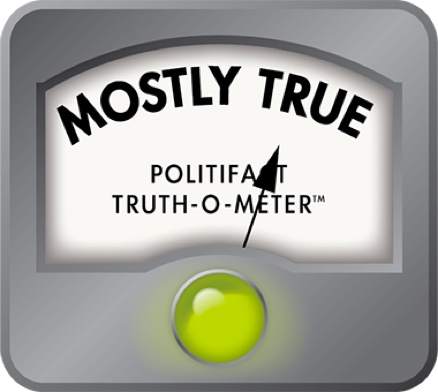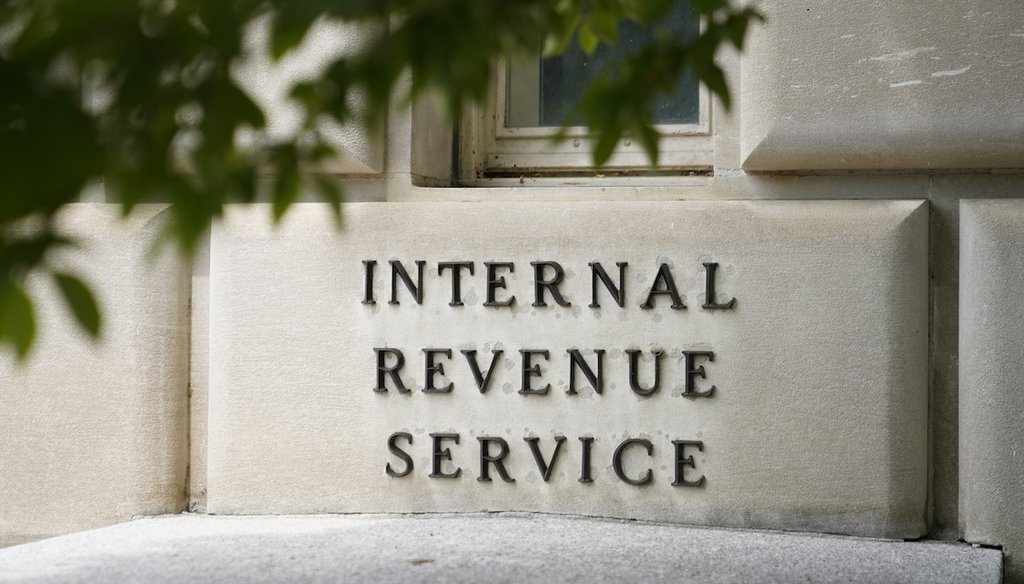

Our only agenda is to publish the truth so you can be an informed participant in democracy.
We need your help.


(AP)
If the Trump-era tax cuts expire, the resulting tax increase would be the largest in peacetime.
The increase would be the largest in dollar amount, though economists use GDP to measure tax increases.
The largest tax increase in American history?
That’s what Rep. Michael Lawler claims would happen if Congress does not pass a budget reconciliation bill by the end of the year.
"The president is focused, as is Congress, on getting a reconciliation bill passed, that actually passes a tax bill, that is critical," Lawler said recently on NewsNation. "If we don’t pass the tax bill by the end of the year, we will have the largest tax increase in American history."
The 2017 Tax Cuts and Jobs Act, signed into law during Donald Trump’s first term as president, nearly doubled the standard deduction.
In addition, the act limited the amount of state and local taxes filers can deduct to $10,000, cut the corporate tax rate, expanded the child tax credit and reduced marginal income tax rates. Some of the changes in the law are set to expire, while others, like the corporate tax rate cut, will not.
Judging the truthfulness of his claim hinges on how you define "largest" tax increase.
The Tax Foundation, which studies federal tax policy, estimates that if the expiring individual provisions are made permanent, the average tax rate for all filers would drop from 20.9% to 19.4%, while the share of filers who itemize would decrease from 33% to 13%. Meanwhile, 9% of filers would see a tax increase while 62% of filers would see a tax decrease.
Credible estimates of the cost of extending the tax cuts over 10 years are in the $4 trillion to $5.5 trillion range, but can change depending on how different revenue actions affect other parts of the economy, and whether extending the cuts are considered in the context of other changes.
But what if the tax cuts expire without a replacement bill?
We reached out to Lawler’s office, and his spokesperson pointed us to an analysis in May from the nonpartisan Congressional Budget Office.
Allowing the tax cuts to expire would result in the single most significant tax increase by dollar amount in history, an estimated $4.6 trillion revenue increase over a decade, from fiscal year 2025 to 2034, including interest.
Lawler’s claim relies on looking at the cost of extending the expiring cuts as a total dollar figure over 10 years – not as a percentage of gross domestic product, which is the way economists measure the impact of tax changes across history.
So a PolitiFact ruling isn't as clear-cut as one may think.
"The single best measure for most purposes is probably the revenue effect as a percentage of GDP, because it eliminates the effects of inflation, real economic growth, and the size of total federal receipts," according to a report from the U.S. Treasury Department. "The second-best measure is probably constant dollars, because it eliminates the effects of inflation and the size of total federal receipts."
Clearly, the expiration of the tax cuts would result in a significant tax increase. But as an annual percentage of GDP, the expiration of the tax cuts in the Tax Cuts and Jobs Act would not be the largest in history, experts told us.
The Tax Foundation, which tracks tax policy and supported the Tax Cuts and Jobs Act, compiled a list of the largest tax increases in history, measuring the revenue changes as an annual percentage of GDP. It estimates that in 2026, if the income tax cuts are extended, revenue would be reduced by $342.4 billion, or 1.08% of GDP. If the tax cuts are not extended, the tax increase would be substantial, but it would not be the largest ever in history, said Erica York, vice president of federal tax policy.
Six tax law changes between 1941 and 1968 led to bigger tax increases as a percent of GDP, York said.
"The expiration (of the Tax Cuts and Jobs Act tax cuts) would, however, be the largest peacetime tax increase, coming in just above the 1982 tax law that increased taxes by .98 percent of GDP," she said.
There are constant dollar comparisons over time that put the first year of extending the Trump cuts as more expensive than prior increases. But experts said that while those do adjust for inflation, they do not reflect changes in the size of the economy.
A Treasury Department analysis in 2006 found the Revenue Act of 1942 cost $73.4 billion in 1992 constant dollars. The first-year cost of extending the Trump tax cuts, in 1992 constant dollars, is $147.8 billion.
Joseph Rosenberg, a senior fellow with the Urban-Brookings Tax Policy Center, warned the Treasury report compares legislated tax increases – not the expiration of tax cuts.
The most comparable situation happened between 2012 and 2013, when a large set of George W. Bush-era tax cuts were scheduled to expire at the same time that a large set of tax extenders and temporary tax cuts enacted in the aftermath of the Great Recession were scheduled to expire. That would have resulted in a tax increase of $500 billion in a single year, in 2013 dollars, Rosenberg said. That would be $694 billion today. Congress extended some of those tax cuts in the American Taxpayer Relief Act.
"So, I don't think there is any question that the total amount of tax increases originally scheduled to take effect between 2012 and 2013 were larger than what is scheduled to occur next year," Rosenberg said. "Congress ultimately voted to extend a large portion of those tax cuts to avoid actually letting that large of a tax increase occur, and I suspect this Congress will be no different."
Lawler claimed Americans would face the largest tax increase in history if the Tax Cuts and Jobs Act expires.
In pure dollar terms, he’s right.
But economists typically use a percentage of GDP to compare the cost of tax cuts or tax increases across time.
Seen this way, the Tax Cuts and Jobs Act expiration would not lead to the highest tax increase ever, as a percentage of GDP, although one credible analysis found that it would mark the largest peacetime increase in history.
Because Lawler’s statement is accurate, but needs clarification or additional information, we rate it Mostly True.
"On Balance with Leland Vittert," NewsNation, via YouTube, March 21, 2025.
CNN transcript, "Town Hall: America Asks Congress," April 10, 2025.
Phone, email interview, Ciro Riccardi, director of communications, senior advisor, Rep. Michael Lawler, April 12, 2025.
Email interview, Erica York, vice president of federal tax policy, Tax Foundation, April 10, 2025.
Phone Interview, Joseph Rosenberg, senior fellow, Urban-Brookings Tax Policy Center, April 11, 2025.
Congressional Budget Office, "Budgetary Outcomes Under Alternative Assumptions About Spending and Revenues," May 2024.
PolitiFact, "Did Trump impose ‘the largest tax hike in our lifetime’? How it compares, as it’s currently proposed," April 7, 2025.
The Tax Foundation, "Making the Tax Cuts and Jobs Act Permanent: Economic, Revenue, and Distributional Effects," Feb. 26, 2025.
Reuters, Fact check: "Joe Biden’s proposed tax increase is not the largest in U.S. history," Oct. 22, 2020.
U.S. Senate Committee on Finance news release, "Wyden, Merkley, Neal, Boyle Release Staggering New Cost Estimate of Republican Tax Plan, Blast Giveaways to Corporations and the Wealthy," April 3, 2025.
Bipartisan Policy Center, "The New Cost for 2025 Tax Cut Extensions - $4 Trillion," April 8, 2025.
Brookings Institution, "Which provisions of the Tax Cuts and Jobs Act expire in 2025?," Sept. 5, 2024.
Congressional Research Service, "The 'Fiscal Cliff' and the American Taxpayer Relief Act of 2012," Jan. 4, 2013.
U.S. Treasury Department, "Revenue Effects of Major Tax Bills," September 2006.
In a world of wild talk and fake news, help us stand up for the facts.
